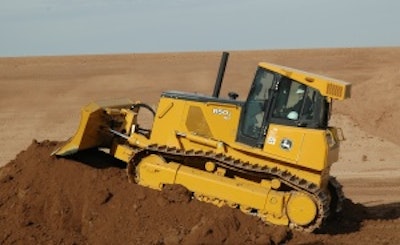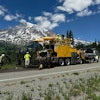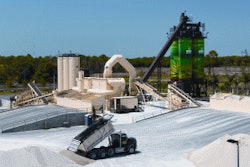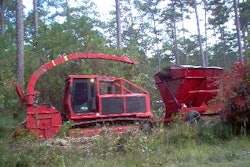
Diesel prices will eventually rise as the economy fully recovers. Couple that with the ever-growing movement to transition away from petroleum-based fuels -- stemming from the desire to achieve energy independence and as a result of the oil spills in the U.S. and China -- and the spotlight is clearly placed on alternative fuels. Currently, biodiesel leads the way in the construction industry.
Yet, the industry faces a major challenge due to recent expiration of the biodiesel tax credit. "The catastrophe in the Gulf is crushingly sad and infuriating to continue to watch month after month," fumes Joe Jobe, CEO, National Biodiesel Board. "But what is almost as frustrating is to hear members of Congress talk about the need for more clean energy sources like wind, solar and advanced biofuels. Meanwhile, their inaction is suffocating the only biofuel that has achieved commercial success in America -- biodiesel."
Blend levels
Biodiesel is used in blends anywhere from B5 (5%) to B100 (100%). OEMs typically determine the most appropriate level of blending to ensure trouble-free performance of their equipment.
"Our engines are approved for B20 now without any additives," says Joe Mastanduno, product marketing manager, engine/drivetrain, John Deere Construction and Forestry Division. "You can use B20 in our present engines, Tier III engines and all of the old engines with no problem. Above B20, you have to start with additives and some preventive actions."
According to Hind Abi-Akar, technical expert, fluids engineering, Caterpillar, "B20 blends are acceptable in the majority of Caterpillar engines. Up to B5 is acceptable in some Tier II and older small engines."
Technical issues regarding increased concentrations of biofuel can be categorized into aftertreatment and fuel system concerns. "Use of blends higher than B20 in aftertreatment-equipped engines can increase the rate of ash deposit in particulate filters," explains Abi-Akar. "Additionally, the lower oxidation stability of biodiesel and the potential contaminants in this fuel (alkali and alkaline metals) may cause or increase common rail fuel system deposits, leading to complaints of low power or black smoke."
The safe ambient temperature operating range can also be affected by the blend level. "Higher blends may have higher cold temperature operability risk (higher cloud point) and may also impact engine oil drain intervals," says Abi-Akar. (Caterpillar requires engine oil testing when higher biodiesel blends are used.)
But there are several successful applications of very high blend levels. "Higher blends of biodiesel are currently being used in certain applications and will continue to be used in the future," says Jobe. "For example, high blends such as B100 are broadly used in underground mining equipment, where reducing the toxicity of exhaust emissions is important to the health and safety of workers or to meet regulatory requirements. This is also the case in warehousing and other indoor applications.
"There are also a number of fleets and individuals who use high blends to maximize their petroleum displacement," he adds.
"Use of B100 does have an increased cost and additional handling and operational effort associated with it," Jobe admits. "For example, B100 does freeze at a higher temperature than No. 2 diesel fuel, so that needs to be taken into account. And B100 can affect some hoses and gaskets -- particularly those in systems before the introduction of 500-ppm sulfur petrodiesel fuel. Therefore, blends up to B20 are expected to continue to be the most popular and make up the majority of usage, as those blends are drop-in replacement fuels that provide the largest benefits for the least cost."
Performance characteristics
"Biodiesel has lower BTU (thermal energy) than diesel due to the chemical nature of the fuel," says Abi-Akar. "At lower blends and up to B20, customers may not notice a power difference compared to diesel fuel. The higher the biodiesel fuel blend, the more the customer may notice the difference. At B100, a loss of 7% to 9% in power may be noticed."
The difference in BTU up to B20 is negligible. "Some fleets actually report an increase in fuel economy with blends up to B20," claims Jobe. "This could be due to some of the other performance properties of biodiesel. For example, biodiesel is naturally low in sulfur (virtually zero) and high in lubricity. This keeps engines and fuel systems cleaner and reduces friction and wear, which can extend engine life."
He adds, "Biodiesel is also naturally high in cetane and contains 11% oxygen by weight, which make it burn cleaner and more completely. Since biodiesel has a naturally high flash point and is non-toxic and biodegradable, biodiesel is safer to handle in all types of operations."
Biodiesel does have limitations in cold weather applications. "The cloud point of biodiesel is higher than that of diesel due to the nature of the fuel," says Abi-Akar. "Biodiesel can form solids at low temperatures, which can plug the fuel filter and prevent fuel flow to the engine."
She explains, "The cloud point and pour point of biodiesel is dependent on the feedstock (soy, used cooking grease, tallow, rapeseed, etc.). In general, the impact increases with the biodiesel blend level. For this reason, lower blend levels are used during winters in cold climates. B2 blends have been used successfully in Canada or northern regions of the U.S. in the winter. It is very important to ensure the cold flow properties of the finished fuel are known and that they are appropriate for the application climate."
Cold flow improvers may allow biodiesel to flow at low ambient temperatures. "It is important to note that additives used to improve the cold flow properties of diesel fuel may not be as effective in biodiesel, in particular for higher blends," says Abi-Akar. Customers should work with their fuel supplier to ensure the fuel has the appropriate cold flow properties for the climate.
She adds, "The biodiesel specification ASTM D6751 and Caterpillar biodiesel specification include multiple tests to ensure the cold flow of biodiesel. In addition to the cloud point and pour point, new tests have been introduced due to collaborative effort in the industry, in which Caterpillar actively participates. These tests include the Cold Filter Plugging Point and Low Temperature Filterability Test."
Purchase and handling
Purchasing and handling of biodiesel requires a little extra care.
"Biodiesel has several issues," Mastanduno indicates. "The biggest is probably the quality of the fuel. Make sure you get it from a good source and have it tested."
Abi-Akar agrees, noting, "High-quality biodiesel is paramount to reducing risk and [ensuring] uninterrupted operation. Use biodiesel from BQ-9000 producers and BQ-9000 marketers and observe the proper handling and storage procedures."
"We advise everyone to only buy ASTM grade biodiesel, and we highly recommend folks buy from BQ-9000 quality certified companies," says Jobe. "The biodiesel industry has been extraordinarily proactive and aggressive on fuel quality efforts, employing what we call the 3-E approach: education, enforcement and encouragement. This includes education of the biodiesel and petroleum industries in proper handling and use; enforcement of state and federal fuel quality and compliance requirements; and encouragement of participation in our national quality assurance program, BQ-9000."
More than 75% of biodiesel production falls under the BQ-9000 program. "Independent surveys by the National Renewable Energy Laboratory have shown that over 90% of biodiesel in the marketplace meets the quality specification, up from 50% five years ago," says Jobe.
"There are very clearly defined quality standards now," says Mastanduno. "Biodiesel didn't get a good reputation initially because there were no standards. But over the last three or four years, they have put these standards in place. I give a lot of credit to the National Biodiesel Board. We feel more confident and we think biodiesel is a very good fuel supply."
Handling is another consideration with biodiesel. "The key issue with the fuel is to make sure there is no water," says Mastanduno. "When you park your machine at night half full, water tends to accumulate in the tank, whether it is diesel or biodiesel. But biodiesel tends to absorb more water. With biodiesel, if you top off your tank at the end of the day, you have a higher success rate. It is also a good idea to have a drain, not only on your storage spot, but also on your machine.
"If you are going to be using a lot of biodiesel, it is probably a good idea to put the extra filtration on to make sure water doesn't get into the fuel system," he adds. "We have a factory-installed option and also a field-installed option to do that."
Biodiesel is also more likely to have algae form than diesel. "That is one of the reasons you should not store it for a long time," says Mastanduno. "When you do buy it, make sure you use it. Don't keep it stored for a long time. If you do store it, make sure it doesn't get hot or cold outside of certain intervals. Biodiesel doesn't like extreme cold or extreme hot. If you follow the guidelines and get it from a very good source, then you shouldn't have any problems, even above B20."
Impact of biodiesel
Above all, the ultimate benefit of biodiesel will be reduced dependence on foreign oil.
"The volume of biodiesel produced is a small percentage of the overall diesel fuel used in the U.S. Current capacity in the U.S. is over a billion gallons per year," says Abi-Akar. However, she notes, "Any biodiesel used is domestically produced, and hence is an enhancement of the local economy and a reduction in the dependence on imported petroleum products. This is important even if the volumes are not high."
"It is all about having our own source of fuel," Mastanduno agrees. "The economic realities start to lean toward biofuels when the price of fuel escalates... Fuel price really drives not just biodiesel use, but other new technologies into the market."



















